Ice Wine Vs Fortified: What's The Sweet Difference?
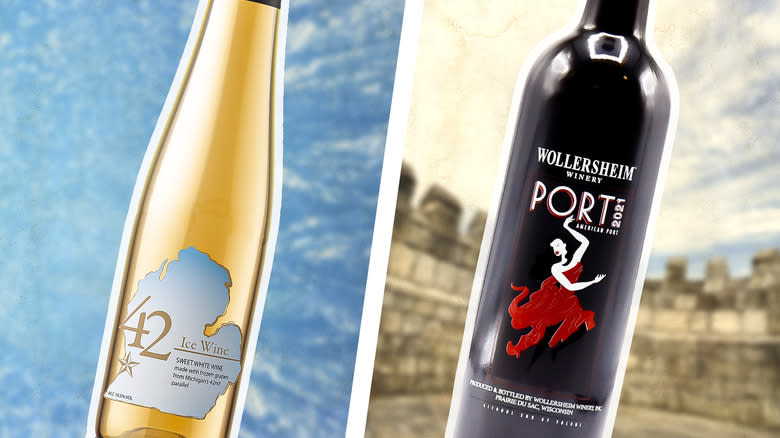
It can be all too easy to throw the "underrated" label around with food and drinks these days, but sweet ice and fortified wines feel genuinely deserving of the term, and it's worth learning the difference between them. Your classic dry wines are respected the world over as complex artisan products that represent their home regions, with restaurants offering dozens if not hundreds of options to cover the wide variety of tastes and styles. Meanwhile, sweet wines are often seen as less fancy — something for people whose palates can't handle anything but a saccharine, syrupy grape juice. Of course, the reality is much different. Dessert wines come in a lot of different styles, and a well-made one can be just as deep and interesting as the most expensive chardonnay. There is a whole unique craft to sweet and dessert wine, and both ice wine and fortified wine are proof of that.
Outside of falling on the sweet end of the spectrum and showing up on the same section of menus, ice and fortified wines are vastly different products. As its name might imply, ice wine is a very specialized product that is only produced in a few colder regions of the world. Fortified wine is a much more wide-ranging term and covers drinks that get produced almost anywhere regular wine does. Two very different ways of processing grapes produce wines that differ in everything from taste to alcohol content to price, but both make for some truly wonderful wines.
Read more: 13 Liquors Your Home Bar Should Have
What Is Fortified Wine?
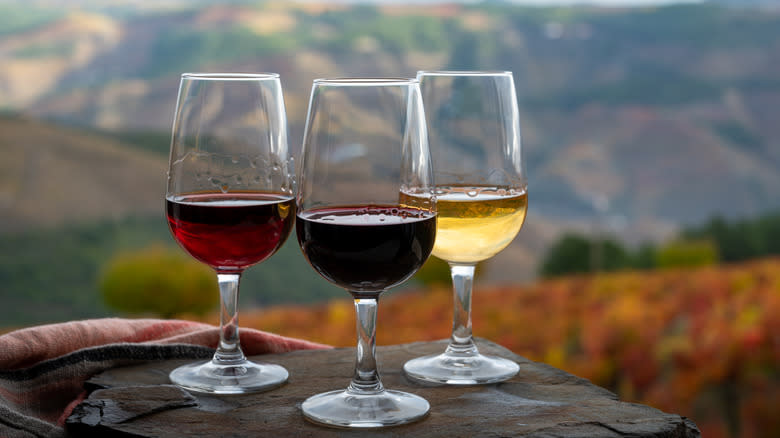
Fortified wine can be confusing because it is a whole sub-category of wine that includes many styles. The one unifying factor in fortified wine is that, at some point in the process, it has another distilled spirit added to it, which increases the alcohol content among other effects, hence the term "fortified." Nothing governs the name of fortified wine beyond this, so it can be made with any style of base wine, with any added spirit, anywhere in the world. However, most of the time, the added spirit is another grape-distilled product, with brandy being a common choice among traditional fortified wines, like Madeira wine. The fortification process was popularized in the 17th century, when the English relied on it as a way to make wine less perishable for shipping on long overseas voyages.
While fortified wine may be a less understood term, there are plenty of familiar wines that fall into the category. Lots of different dessert wines like port and sherry are fortified. These specific styles and their labels are often more tightly regulated, with wines like Marsala only being made using specific grapes or only allowed to fall within certain alcohol levels. Aromatized wine products like vermouth are also fortified wines, as they add a spirit along with the herbs and botanicals that give them their unique taste. As anyone who's ever had both a port and a dry vermouth can tell, these styles of fortified wine can vary wildly in taste.
What Is Ice Wine?
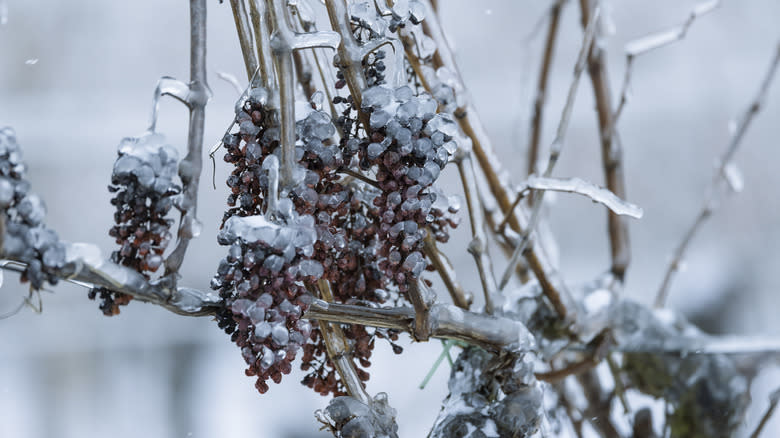
Ice wine is a much more specific type of wine than fortified. The name refers to how the grapes are handled, as ice wines are produced by letting them freeze as they stay on the vine into winter. The creation of ice wine is credited to late 18th or early 19th century Germany, where it is called eiswein. Ice wine was created by accident when German farmers intentionally left grapes on the vine so they could feed their animals during a harsh winter. When the farmers realized how sweet the frozen grapes tasted, they decided to try pressing it into wine instead. Today, Germany is still a top producer, but a lot of great wine produced in Canada is now ice wine, along with the Northern United States.
The frozen grapes used in ice wine produce sweeter juice because some of the water stays behind as ice crystals when the grapes are pressed, resulting in a more sugar-concentrated syrup. Ice wine is sensitive to ideal temperatures, and the weather needs to get down to around 20 degrees Fahrenheit to produce the best outcome. Importantly, grapes must freeze on the vine to legally use the term "ice wine," and grapes that are frozen commercially after being picked can't use the name. While the process for making it is strict, ice wines can be made from a variety of grapes, particularly ones that already do well in cold weather, like riesling and cabernet franc.
Not All Fortified Wine Is Sweet
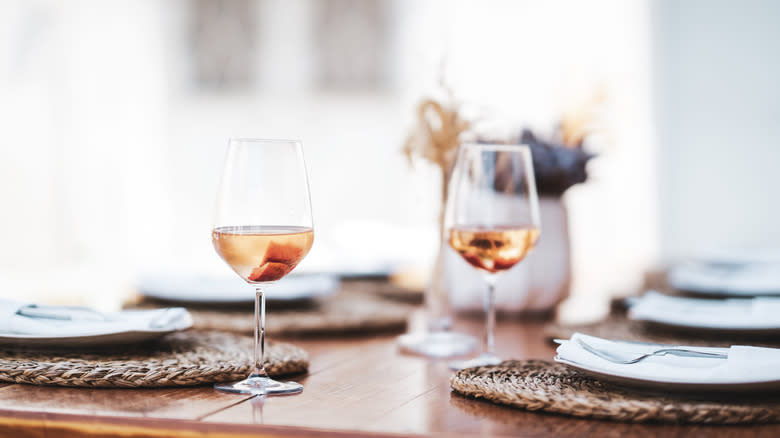
While lots of fortified wines have a sweet flavor, they can range in taste from dry to semi-sweet and fully sweet. What controls the sweetness of fortified wine isn't the specific grapes or ingredients but how the winemakers alter the process. The big factor is at which point the extra spirit is added to the wine, because wine gets less sweet as it ferments and the yeast in the mixture consumes more sugar. If the spirit is added at the beginning of the process, the extra alcohol will kill the yeast, leaving a very sweet wine, but the longer the winemaker waits, the drier it gets. This gives winemakers a lot of leeway in choosing a flavor.
Ice wine, however, is always sweet. In fact, the process that produces it makes wine that can be very, very sugary. Grapes are harvested not just frozen but often at night so that they stay maximally cold and concentrated. This results in only about 10-20% of the juice of a normal grape. The syrup is so sweet that it takes up to six months for the liquid to become drinkable as wine, and even after that time, ice wine's sugar concentration, or brix level, can be twice as high as Coca-Cola's. For the best ice wines, that sugary flavor is balanced by some acidity and flavor complexity from the aging process, but the end result is always some of the sweetest wine you can buy.
Ice Wines Have Less Alcohol
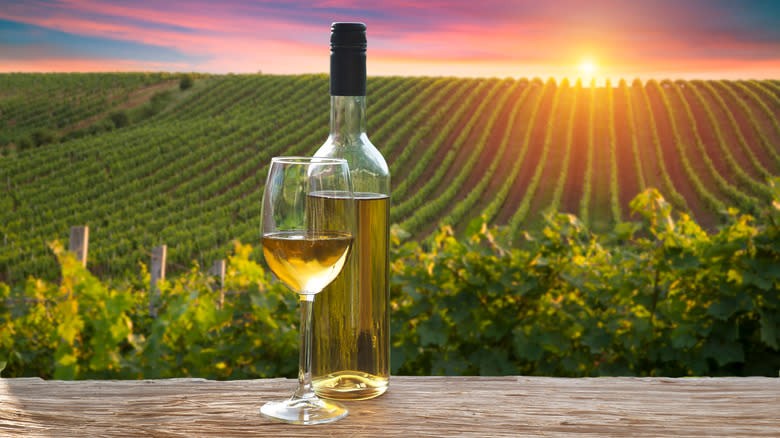
While ice wine falls very high on the sugar scale, it's on the opposite end of the alcohol by volume (ABV) scale. While wines can vary anywhere from 5%-20% ABV, your typical less sweet, dry table wines like pinot grigio, cabernet sauvignon, and merlot fall in the range of 11.5%-14%. Ice wines, on average, are between 6% and 10% ABV. Why is that? Normally, the sugar in grape juice gets converted into alcohol as it ferments, so sweet grapes have greater potential for high alcohol contents, but with ice wine, there is a twist. The wine juice concentrate from frozen grapes is so sweet that it actually makes it hard for yeast to survive. This causes weaker fermentation that stops before most of the sugar is consumed, yielding comparatively little alcohol.
In clear contrast, fortified wines are some of the strongest wines you can find, which isn't surprising considering the extra alcohol added. Because fortified wines cover such a wide variety of products, their alcohol levels can vary a lot too, but most of the best-known and most popular styles fall into a range of 15%-20% ABV. On the lower end are sherries, which usually land at 15%-17%, while Marsala wines are a little higher at 17%-18%. Port is some of the strongest fortified wine, from a low of 19% to as high as 22% alcohol. Vermouths also fall into this range at somewhere between 15%-18% ABV.
Fortified Wine Covers A Wide Variety Of Styles
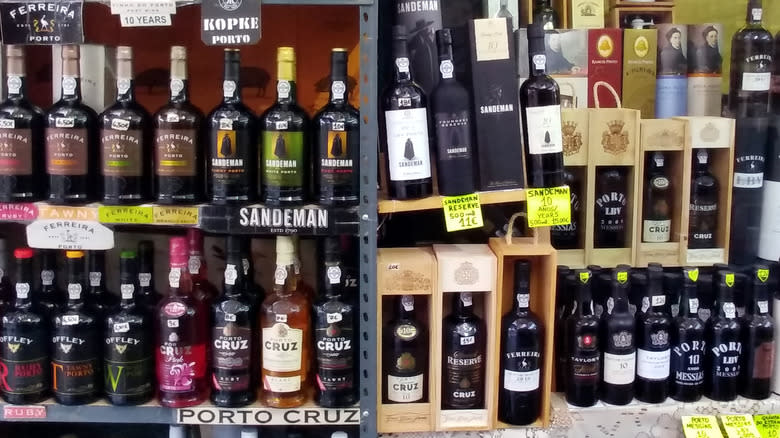
While the most well-known categories of fortified wine, like port and Marsala, are dessert wines, the style is so flexible that lots of drinks you might not think of also fall into the category. In particular, aromatized wine like vermouth contains lots of digestives and aperitifs. Not all drinks in those classifications are fortified wine, but some popular brands like Lillet, Dubonnet, and Cocchi Americano are, as well as some but not all amaro brands. Another lesser-known style in the U.S. is the Italian aromatized wine Barolo Chinato, which infuses one of Italy's best wine grapes with grappa or grain alcohol, herbs, spices, and cinchona, which is the bark used to produce quinine.
Ice wines are much more uniform, but that doesn't mean there aren't meaningful differences in bottles. Ice wines will carry the same differing tasting notes of the grape varietals they're made from, and while they will lean much more fruity than normal wine, they can mix the taste of honey, spice, tropical fruit, and berries in one package. Ice wines made from white grapes will tend to be more bright and fresh tasting, while red grape ice wines may have more spice to them. Don't let the high sweetness scare you off ice wines as they can be a truly lively experience full of the deep flavor profiles wine lovers crave.
Ice Wines Tends To Be Expensive
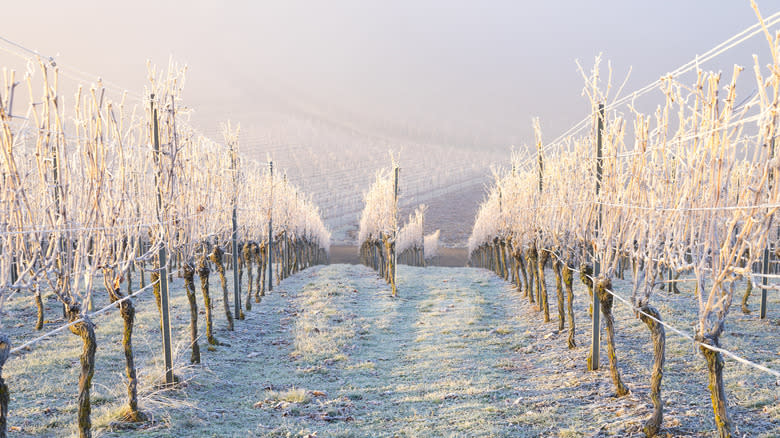
One downside of ice wine is that it can be considerably more expensive than other wines. The highly concentrated juice means that it takes 4-5 times as many grapes to produce sweet ice wine as normal wine. Ice wine is high risk, because the long stay on the vine into winter opens them up to a wider variety of adverse weather events that could spoil them, and it gives animals and birds more time to pick them off. Finally, the delicate and specific nighttime harvesting process means making ice wine is very labor intensive, adding additional costs. All this means ice wine bottles are usually only half the size of a normal wine bottle but will still cost anywhere from $30 to $50 for a cheap to mid-range brand despite having a low alcohol content.
Similarly, fortified wine's price will vary a lot because of the styles, but there are plenty of budget options, and its larger size and higher alcohol content also mean a bottle should last you longer than ice wine. There are supermarket budget brands like Taylor or cheap options at Trader Joe's, where a bottle of port or sherry comes in at around $10. Aperitifs like Lillet and even higher-quality popular vermouth brands like Dolin and Noilly Prat will be around $20. That price point is great for being able to try all the different styles and is one of the big appeals of fortified wine.
Read the original article on Tasting Table.

